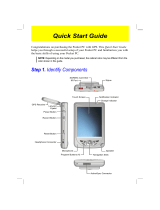
iii
Health and Safety Information
Electrical and Battery Safety
U
Please use ONLY accessories approved by the manufacturer. Any
battery, AC adapter or cable of which authenticity is not verified
by authorized service point or dealer (even if similar to original
product in appearance or specifications) should not be used
with your Pocket PC. The warranty of your Pocket PC DOES NOT
apply to damage caused by use with non-manufacturer
approved products.
U
Follow the specifications of the battery manufacturer: Avoid
charging the battery when the environmental temperature is
higher than 45ºC. Do not store or use the battery when the
environmental temperature is higher than 50ºC. Otherwise,
battery expansion or leakage may occur.
U
Do not attempt to disassemble, pound, pierce or damage the
battery to avoid causing injury, danger or risk.
Application Environment Safety
U
Do not directly expose the Pocket PC to any of the following
environments: rapid changes of temperature, high temperature
(such as direct exposure to sunlight or stoves), extremely low
temperature, high pressure, areas with electrostatic discharge
interference or dusty and humid places. Do not soak or wet the
Pocket PC with water or any other liquid.
U
Do not place the Pocket PC near electrical appliances (such as
TVs, computers, scanners, disc players, faxes, hair dryers, etc.)
that may generate electrostatic discharge interference.





















